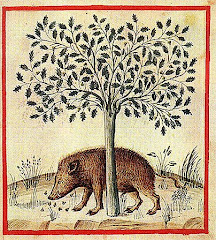 But first I'd like to tell a story about a bit of desk-top plant exploring which started 2 or 3 years ago and which I feel is finally drawing to a close with some rather interesting and entertaining discoveries. It started with the Doctrine of Signatures bed I was developing at the National Botanic Garden of Wales.
But first I'd like to tell a story about a bit of desk-top plant exploring which started 2 or 3 years ago and which I feel is finally drawing to a close with some rather interesting and entertaining discoveries. It started with the Doctrine of Signatures bed I was developing at the National Botanic Garden of Wales.The Doctrine of Signatures is the concept that God (or a creative power of your choosing) has placed marks or "signatures" on many plants which somehow convey their most suitable medicinal uses.
The most common examples of this include plants such as lungwort (Pulmonaria officinalis) with white-blotched leaves which indicate its usefulness in lung diseases (a potent plant that is indeed used by some qualified practitioners as an expectorant) and pilewort (Ranunculus ficaria) which sports a clump of small nodules for roots that many think look remarkably like haemorrhoids (the nodules themselves have been used as suppositories in the past, but are more commonly made into an astringent ointment - which is also potentially toxic).
The philosophy tends to look upon plants with yellow such as dandelion (Taraxacum officinale) and barberry (Berberis vulgaris) as being good for the liver whilst plants with red such as love-lies-bleeding (Amarathus caudatus) and bloody veined dock (Rumex sanguineum) as being good for the blood.
Likewise, plants with hollow stems are good for the "tubes" (airways, digestive system etc) and plants with interesting shaped tubers... Well, that's where this story is going.
 One of the plants I found to fill that bed was Orchis mascula, the early purple orchid (pictured above), a plant I may have added for slightly dubious reasons given that the bed was primarily designed with the entertainment of children in mind.
One of the plants I found to fill that bed was Orchis mascula, the early purple orchid (pictured above), a plant I may have added for slightly dubious reasons given that the bed was primarily designed with the entertainment of children in mind.But this plant is too good to miss where the doctrine of signatures is concerned. The plant produces two small, round tubers which take turns to supply it with the energy it needs to flower, set seed and survive the winter. At any one time, one of the tubers is younger, harder, and firmer, whilst the other is a little older and more shrunken. When I obtained 5 cultivated early purple orchids for my doctrine of signatures bed, I remember checking as I planted them and yes, their equipment was exactly as described.
 This plant has been celebrated for centuries and across many cultures for its reputed aphrodisiac qualities, even Dioscorides appears to have mentioned it in AD1. I learned that in Medieval Britain and even until the 18th century in London, a hot drink called Saloop was sold on street corners. The contents of this drink seems to vary in different accounts with different combinations of aromatic herbs and other ingredients, but the key feature was the dried powdered tuber of the wild orchid - a substance high in starches, proteins and mucilage according to Barker's 'Medicinal Flora of Britain and Northwestern Europe'.
This plant has been celebrated for centuries and across many cultures for its reputed aphrodisiac qualities, even Dioscorides appears to have mentioned it in AD1. I learned that in Medieval Britain and even until the 18th century in London, a hot drink called Saloop was sold on street corners. The contents of this drink seems to vary in different accounts with different combinations of aromatic herbs and other ingredients, but the key feature was the dried powdered tuber of the wild orchid - a substance high in starches, proteins and mucilage according to Barker's 'Medicinal Flora of Britain and Northwestern Europe'.The best British saloop appears to have come from Oxfordshire, but even better than that was the stuff imported from Turkey where the drink is still popular today. Known there as salab or salep, it translates roughly as 'testicles of the fox' and each spring new tubers are harvested by villagers of certain mountain regions where the finest orchids are said to grow.
Three years ago when I first came across saloop I was keen to try some. But, as is so often the case with orchids, there are major conservation issues to consider. Many wild orchids are protected and the decline in their population (along with the introduction of coffee) goes a long way to explaining why saloop fell out of favour in the UK. In Turkey, where the industry is still a small but thriving one, there are also discussions being had about over harvesting and I found several papers on the net which were looking into the possibility of salep substitutes that might be suitable for Turkish communities in Germany.
I wondered briefly about the potential for harvesting my own from the 5 cultivated plants I had bought. Sadly they take such a long time to grow and the first indication that they were beginning to spread in the Doctrine of Signatures bed was late last summer, just before I left the botanic garden. I decided to forget all about saloop until such time that I might be able to try growing my own orchids again.
But then, this year, I was given a new cookery book by my parents. The book is called 'Silk Road Cooking - a vegetarian journey' by Najmieh Batmanglij. The book in itself is beautiful, the recipes are stunning. We've hardly eaten a meal that hasn't come from that book in the last 6 weeks. And at the back, in the dessert section, what did I find but a recipe called '1001 Nights Chewy Saffron Ice Cream'. It looks absolutely gorgeous and I confess, I've nabbed a picture of it to give some idea:
 I desperately wanted to try making it, but I found myself stumped by one of the ingredients: 'salab mixture'. I did a bit of research and suddenly found myself confronted by the whole saloop story all over again. This time, with the added appeal of the ice cream, I found myself even more desperate to track down some salep and give it a try.
I desperately wanted to try making it, but I found myself stumped by one of the ingredients: 'salab mixture'. I did a bit of research and suddenly found myself confronted by the whole saloop story all over again. This time, with the added appeal of the ice cream, I found myself even more desperate to track down some salep and give it a try.Our first few attempts turned up nothing in the Asian shops of Swansea and led me to research the name more carefully because there are so many variations. This time I turned up one of the most entertaining articles I've read in a long time. Writing for the Telegraph, Eric Hansen (author of Orchid Fever) describes his journey to Turkey to investigate stories of the stretchy 'salepi dondurma' (fox testicle ice cream) which must be eaten with a knife and fork and which can be pulled into a skipping rope.
Particularly interesting to me was his description if the taste:
"...a hint of mushrooms, yak butter and the smell of a goat on a rainy day."Intrigued, I've considered trying to make the ice cream in my recipe using some alternative thickener, but still we kept searching the Swansea shops in case we should get lucky. Then, the other day, we did. My partner Cameron brought me a pudding mix called sahlab which contained a mix of orchid root, cornstarch and sugar.
As I said, I'm not entirely comfortable with this because of the conservation issues, but I figured a one off try was necessary to find out why this ingredient is so vital when there are so many other potential mucilages and thickeners around. I came to the conclusion that if it really is unique I realy would try growing my own one day, though at nearly £10 per plantlet, it's not the most lucrative of herbs to be foraging from.
So last night I divided the contents of our pudding kit in two. One half is being saved to see if I can try making that chewy saffron ice cream after all. The other half I mixed with milk and began stirring on the hob in one direction only, as per instructions, until the whole thing thickened to an almost solid, smooth white paste. To this I added a small amount of rose and orange blossom water and sprinkled it with a little cinnamon as suggested. And off we went to try it.
I must confess, the flavour wasn't all that noticeable. The rose and orange predominated, but there was a savoury background flavour almost reminiscent of...potato...? I certainly didn't get a mouldy goat vibe from it.
The texture I think is the all important bit. The paste thickened far more substantially than it would with cornstarch alone and although the instructions told me to bring the milk to boiling point, this was nearly impossible since the paste was too thick to allow bubbles of air to escape. Even now, the leftovers sit in the pot in an almost solid shiny block.
I'm glad to have finally tried this stuff although I had hoped to come to a more definite conclusion as to its worth (as a food rather than anything else), but I find myself wishing I could begin growing those orchids sooner rather than later so that I can try it real and unadulterated. I still have the second half of my pudding mix and I'll be sure to let you know if and how the chewy ice cream works out. And of course, if anyone reading this has any salep stories to tell, I'd love to hear.
NB. As mentioned, it is illegal to dig up wild orchids in this country. For anyone who is interested in growing their own Orchis mascula, plants can be obtained from The herb Garden and Historical Plants Nursery




















3 comments:
Thank you for a truly wonderful and inspiring post, Katrina. Now you've got me wanting to taste the ice cream! I have a dim memory of reading about saloop in early times. I have a common spotted orchid growing happily at the Sanctuary -maybe I should branch out and grow my own orchis mascula!
Hi Sarah,
I'm glad you liked the post, hopefully the ridiculous length it reached makes up for my recent failure to keep up with posting.
Yes, I think you should try growing Orchis mascula. The plants aren't exactly cheap, but they were far easier to get settled than I had expected and, as I mentioned, there were maybe 5 little shoots of new plants appearing at the end of last summer so I may have doubled the number within 3 years.
Mine were growing in bark mulch which they seemed to really like, though the wild ones nestled amongst the mosses always look so much more appealing if you can manage it.
Hi Kristina,
You've been awarded a Bella Award for your blog. To find out more go to http://kitchenherbwife.blogspot.com/2009/05/new-blog-award.html
Post a Comment